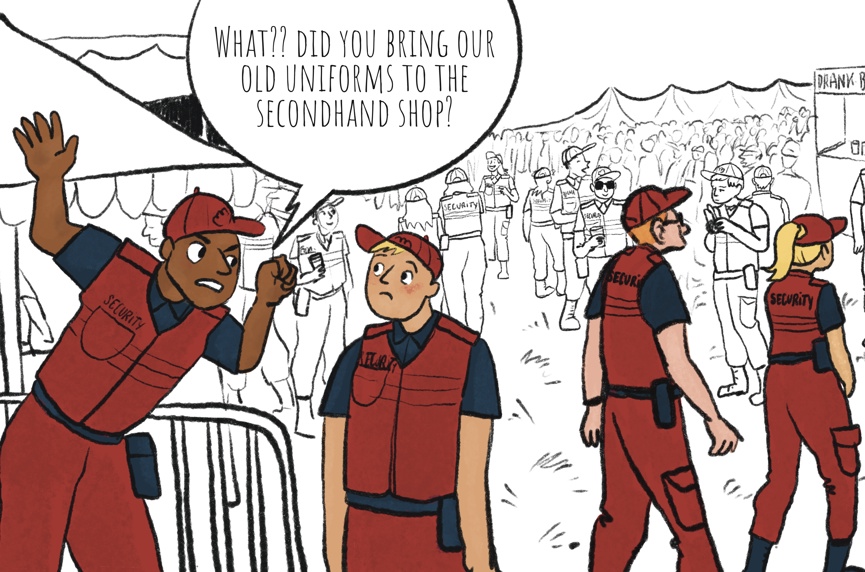- Liability and Insurance
- Uniforms in the private security sector , uniform , private security sector , the visibility of uniforms , the traceability of the uniforms , uniform decree , security guard , private security uniforms , the security company
In the security sector, the rules governing uniforms have long been set by the ministerial decree of 8 June 2007.
This decree was repealed by a new ministerial decree of 19 July 2024.
While most of the old rules have been maintained, the government has deemed it necessary to revise some of them and to complete the regulatory framework on certain points.

In particular, rules have been introduced
- to increase the visibility of uniforms (eventually with the introduction of the obligation to mention the company name);
- to guarantee the traceability of the uniforms;
- to make security guards more aware of their uniform-related responsibilities.
This new “uniforms decree” came into force on September 12, 2024.
However, two transition periods have been granted, which will be explained further down in this article.
Hereafter is a summary of the rules:
1. Uniform features
The authorized colors are kept: black, white, yellow and red, as well as their mixture colors (gray, pink, orange, etc.).
The absence of blue and green is explained by the clear intention of the government to forbid any confusion with the uniforms of law enforcement agents or the military.
This prohibition also extends to all parts, decorations, elements and even accessories that could lead to confusion with the uniforms of the latter.
The new decree lays down an additional rule, namely the obligation to indicate on the upper parts of the uniform the official name/abbreviation of the security company, so that citizens can see from a reasonable distance to which company the security guard belongs.
In addition to this name, the uniform may include :
- the distinctive sign of the company or service;
- its trade name (provided it is mentioned in the authorization order);
- the words “GARDIENNAGE”, “BEWAKING”, ′′SECURITY′′, ′′SECURITE′′, ′′VEILIGHEID′′ and/or “SICHERHEIT”;
- the words “DIRIGEANT”, “LEIDINGGEVENDE”, “LEITER” and/or “LEADER” (for persons performing a function combining executive and managerial functions).
We are delighted that the government has finally allowed the use of the terms “bewaking / gardiennage” and the third national language (“sicherheit”), which had been neglected for 17 years...
The obligation to wear the VIGILIS emblem is maintained: it must always be fixed at chest height on the right.
No other wording is permitted.
2. Storage, distribution, monitoring, return and destruction
The aim of the Private Security Department of the government is to prevent ill-intentioned persons from gaining possession of security guard uniforms. As with police and military uniforms, it is essential to avoid at all costs that private security uniforms be stolen, untraceable or sold on markets or via mail-order websites.
Rules are laid down for stock management, traceability (according to a system chosen by the security company) and reporting in the event of theft of uniforms.
The security company or department keeps an inventory of uniform items in stock. Incoming and outgoing uniform items must be recorded.
Uniform parts issued must be traceable, in the sense that the security company or department must know at all times which parts are with which security agent.
Furthermore, the uniform decree lays down precise rules for the delivery of the uniform to the security agent (by hand, by sending a parcel against acknowledgement of receipt, or by handing it over to a secure locker or collection point), with a list to be checked by the security agent, as well as the return of the uniform to the security company.
As before, security agents have 5 working days to return their uniforms when they definitively cease their activities.
The new provisions provide for a formal notice mechanism if this deadline is not respected, as well as the possibility of retaining the lower parts of the uniform, subject to the employer's authorization.
3. Management and use of uniforms
The security agent is responsible for the uniform and its parts supplied to him/her, and must take all necessary measures to ensure that unauthorized third parties cannot gain possession of any of them.
It is forbidden for the security agent to sell, lend, exchange or give away any of these uniform items.
The security agent shall immediately report to the security company or department any loss or theft of uniform items made available, and within 48 hours of discovery of the theft or loss, also report it to the police, unless the security company has already done so.
Security agents may only wear their uniforms while carrying out their duties and while travelling to and from work.
When carrying out his duties, the agent wears the uniform items assigned to him. Personal clothing may only be worn in a non-visible manner (except for personal accessories such as hats, belts or gloves, and always on condition that they do not give rise to confusion with military or law enforcement equipment).
4. Transitional provisions
The uniforms decree came into force on 12 September 2024.
The articles relating to
- inventory and tracing of uniform items, and declaration of theft;
- the supply and return of uniform items;
- the procedure in the event of non-return of the uniform by the security agent.
will come into force on 1 April 2025.
If you would like more information or assistance on this matter, please do not hesitate to contact our specialists at info@be.Andersen.com or +32 (0)2 747 40 07.



